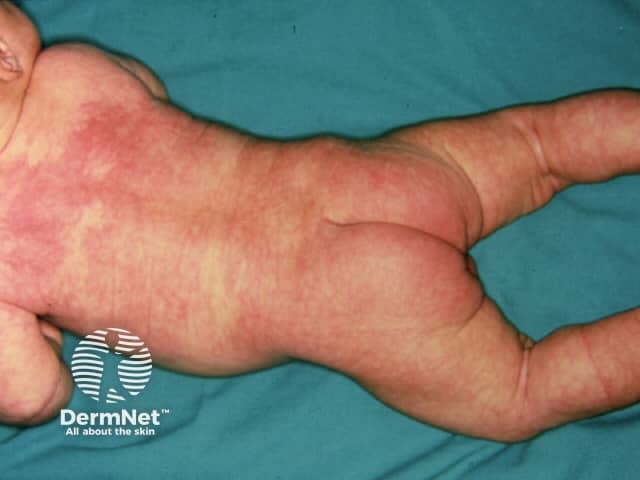Main menu
Common skin conditions

NEWS
Join DermNet PRO
Read more
Quick links
Cornelia de Lange syndrome — extra information
Cornelia de Lange syndrome
Author: Brian Wu, MD candidate, Keck School of Medicine, Los Angeles, USA. DermNet New Zealand Editor in Chief: Hon A/Prof Amanda Oakley, Dermatologist, Hamilton, New Zealand. December 2016.
Introduction Demographics Causes Clinical features Diagnosis Treatment Outlook
What is Cornelia de Lange syndrome?
Cornelia de Lange syndrome is a rare, genetic disorder that affects virtually every bodily system and leads to an array of physical and cognitive deficits. Most children with this syndrome are diagnosed at birth.
It has a number of other names, including de Lange syndrome, Amsterdam syndrome, Brauchman–de Lange syndrome, Amsterdam dwarf, degenerative amstelodamensis typus, and Bruck–de Lange syndrome. It was first described by Cornelia de Lange in 1933, although Brauchman wrote up a similar case in 1915.
Who gets Cornelia de Lange syndrome?
Cornelia de Lange syndrome is rare.
- The incidence is estimated to be around 1 in every 10,000–30,000 live births. This might not be entirely accurate, as the syndrome can go undiagnosed when its symptoms are mild or unusual.
- It affects both sexes.
- It is diagnosed in people of all races and ethnicities.
- Most patients have no family history of the syndrome.
What causes Cornelia de Lange syndrome?
Cornelia de Lange syndrome is a genetic disorder.
- Most cases are due to the mutation of any one of five genes: NIPBL, SMC1A, HDAC8, RAD21 and SMC3. These genes encode the proteins needed to develop the face and limbs before birth.
- Mutations in these five genes are absent in 30% of investigated cases of Cornelia de Lange syndrome. As such, scientists suspect there may be genes involved other than the ones already identified.
- The pattern of inheritance is autosomal dominant pattern; that is, an abnormal gene from one parent can cause disease.
- The mutations are often sporadic, accounting for why there may be no recorded family history of the syndrome.
What are the clinical features of Cornelia de Lange syndrome?
Cornelia de Lange syndrome has complex manifestations, which can range from mild to severe. These manifestations include:
- Growth and development abnormalities, including low birth rate, delayed growth, intellectual disability (including learning disabilities and language delays) and autism-like syndromes that affect socialisation and communication
- Distinctive facial features, such as synophrys (narrow eyebrows that meet in the middle), an upturned nose, uneven teeth, low-set ears and thin lips; a cleft palate is also possible
- Limb abnormalities, including missing arms or forearms, small hands and feet, and clinodactyly (incurving of the fifth finger)
- Digestive problems, such as gastro-oesophageal reflux
- Heart defects, such as atrial septal defect or tetralogy of Fallot
- Eye problems, including blepharitis (inflammation of the eyelid), ptosis (drooping eyelids) or myopia (near sightedness).
Skin disorders found in Cornelia de Lange syndrome include:
-
-
Cutis marmorata telangiectatica congenita (a purplish marble-pattern discoloration)
- Prominent dermatoglyphics (fingerprints and ridges on the palms).
-
Cutis marmorata telangiectatica congenita (a purplish marble-pattern discoloration)

Cutis marmorata
How is Cornelia de Lange syndrome diagnosed?
The diagnosis of Cornelia de Lange syndrome is based on clinical findings of its characteristic signs and symptoms as evaluated by a physician. Genetic studies may be performed by specialist laboratories.
How is Cornelia de Lange syndrome treated?
Treatment for Cornelia de Lange syndrome is lifelong and can be complex, with differences depending on each specific case. Treatment can include:
- Psychiatric treatment for behavioural or cognitive problems
- An individualised education plan with the child’s parents and school to help address cognitive and intellectual delays.
- Multidisciplinary specialist care, including a team of a cardiologist, dentist, ophthalmologist, audiologist, gastroenterologist and orthopaedic surgeon, depending on the particular child’s needs.
What is the outlook for Cornelia de Lange syndrome?
Patients with Cornelia de Lange syndrome may survive into adulthood with the right care and treatment. However, they are vulnerable to a number of serious conditions.
In one review of 295 cases of this syndrome, causes of death, in order of frequency, included:
- Respiratory disease
- Gastrointestinal disease
- Congenital anomalies
- Nervous system diseases
- Accidents
- Sepsis
- Cardiac disease
- Cancer
- Renal disease.
References
- Cornelia de Lange Syndrome Foundation. About CDLS. 2016. Available at: www.cdlsusa.org/what-is-cdls (accessed July 2016).
- Genetic Home Reference, US National Library of Medicine. Cornelia de Lange syndrome. 2016. Available at: http://ghr.nlm.nih.gov/condition/cornelia-de-lange-syndrome/#diagnosis (accessed July 2016).
- National Organization of Rare Diseases (NORD). Cornelia de Lange syndrome. 2016. Available at: http://rarediseases.org/rare-diseases/cornelia-de-lange-syndrome (accessed July 2016).
On DermNet
Other websites
- Cornelia de Lange syndrome — Medscape
- Cornelia de Lange syndrome — GARD
